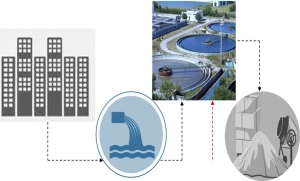Wastewater: Waste or Resource?
India
has 2.5% of the global landmass and 4% of the world’s freshwater resources.
But the water stress has increased in India as it is home to almost 18%1 of
the world’s population and the distribution of freshwater is highly skewed,
both spatially and temporally. It is also used very inefficiently and
incessantly. Water demand in India is expected to increase due to rapid
urbanisation and industrialisation along with the already existing high
demand for agriculture. The annual water availability per capita has reduced
from 1816 cu.m in 2001 to 15442 cu.m in 2011 and is expected to plummet
further to 1465 cu. m by 2025 and 12353 cu. m by 2050. To add to that, the
topographic constraints in most regions of India, distribution patterns,
climatic conditions, technical limitations and poor management do not allow
India to harness its water resources efficiently. The urgency to conserve
water resources is huge at present. Potable water is a valuable commodity
which must be used with utmost care.

Construction industry consumes enormous amount of water, second only to agriculture. The activities of construction in water stressed regions add to the already prevailing problems related to availability of potable water for daily use. Cement is the second most used material after water and its production and use involves huge quantity of potable and fresh water. The water consumption for cement has varied between 250-305L/tonne of cement production4. It is worrisome to know that concrete industry was responsible for 1.7%5 of all global water withdrawals. It is also expected that between 2012 and 2050, India will increase its concrete production by 90%6. Thus, it is important to have access to recycled wastewater that can be used by the construction industry.
Currently, the wastewater generation of urban India is 617547 MLD while the treatment capacity is 22963 MLD. This treated wastewater is mostly used in the agriculture sector and for ground water recharge, horticulture purpose and for maintaining base flow of rivers, ponds and water reservoirs. Unfortunately, treated wastewater is not seen as a major resource in India yet. The secondary and tertiary treated wastewater as per CPCB norms can be put to much efficient use. To adopt this in a sustainable manner, using treated wastewater by replacing potable water in the construction industry could be a viable option that must be deliberated upon. Few research studies have been conducted on this at a very small scale in laboratories but in India it has not yet been considered. Efforts must be taken through the aegis of government departments and industries together to conserve fresh water resources and view the treated wastewater as a resource. ■
Endnotes:
1
https://www.downtoearth.org.in/blog/water/challenges-in-the-management-of-water-in-india-58275
(Website accessed
on 14th August 2020)
2 http://nwm.gov.in/?q=synopsis-water-data-india (Website accessed on 18th August 2020)
3https://www.thehindubusinessline.com/economy/agri-business/indias-per-capita-water-availability-to-decline-further-icar/article29342714.ece (Website accessed on 18th August 2020)
4 https://www.globalcement.com/ (Website accessed on 18th August 2020)
5 Miller, S. A., Horvath, A., & Monteiro, P. J. (2018). Impacts of booming concrete production on water resources worldwide. Nature Sustainability, 1(1), 69-76.
6 https://www.fluencecorp.com/concrete-industry-water-use/ (Website accessed on 16th August 2020)
7 http://www.sulabhenvis.nic.in/Database/STST_wastewater_2090.aspx
Neha Agarwal
nagarwal@devalt.org